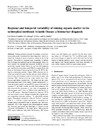Please use this identifier to cite or link to this item:
https://accedacris.ulpgc.es/jspui/handle/10553/2945
| Title: | Regional and temporal variability of sinking organic matter in the subtropical northeast Atlantic Ocean: a biomarker diagnosis | Authors: | Alonso-González, Iván J. Aristegui, J. Lee, Cindy Calafat, Antoni |
UNESCO Clasification: | 251001 Oceanografía biológica | Keywords: | Sediment traps Carbon flux Biomarkers Canary region |
Issue Date: | 2010 | Journal: | Biogeosciences | Abstract: | Sinking particles through the pelagic ocean have been traditionally considered the most\nimportant vehicle by which the biological pump sequesters carbon in the ocean interior.\nNevertheless, regional scale variability in particle flux is a major outstanding issue in\noceanography. 5 Here, we have studied the regional and temporal variability of total particulate\norganic matter fluxes, as well as chloropigment and total hydrolyzed amino acid\n(THAA) compositions and fluxes in the Canary Current region, between 20–30 N, during\ntwo contrasting periods: August 2006, characterized by warm and stratified waters,\nbut also intense winds which enhanced eddy development south of the Canary Islands,\n10 and February 2007, characterized by colder waters, less stratification and higher productivity.\nWe found that the eddy-field generated south of the Canary Islands enhanced\nby >2 times particulate organic carbon (POC) export with respect to stations (FF; farfield)\noutside the eddy-field influence. We also observed flux increases of one order of\nmagnitude in chloropigment and 70% in THAA in the eddy-field relative to FF stations.\n15 Principal Components Analysis (PCA) was performed to assess changes in particulate\norganic matter composition between stations. At eddy-field stations, higher chlorophyll\nenrichment reflected “fresher” material, while at FF stations a higher proportion of\npheophytin indicated greater degradation due to microbes and microzooplankton. PCA\nalso suggests that phytoplankton community structure, particularly the dominance of\n20 diatoms versus carbonate-rich plankton, is the major factor influencing the POC export\nwithin the eddy field. In February, POC export fluxes were the highest ever reported\nfor this area, reaching values of 15 mmolCm−2 d−1 at 200m depth. Compositional\nchanges in pigments and THAA indicate that the source of sinking particles varies\nzonally and meridionally and suggest that sinking particles were more degraded at\n25 near-coastal stations relative to open ocean stations. | URI: | https://accedacris.ulpgc.es/handle/10553/2945 | ISSN: | 1726-4170 | DOI: | 10.5194/bg-7-2101-2010 | Source: | Biogeosciences[ISSN 1726-4170],v. 7, p. 2101-2115 | Rights: | by-nc-nd |
| Appears in Collections: | Artículos |
SCOPUSTM
Citations
22
checked on Jun 8, 2025
WEB OF SCIENCETM
Citations
22
checked on Jun 8, 2025
Page view(s)
220
checked on Sep 27, 2025
Download(s)
247
checked on Sep 27, 2025
Google ScholarTM
Check
Altmetric
Share
Export metadata
This item is licensed under a Creative Commons License


